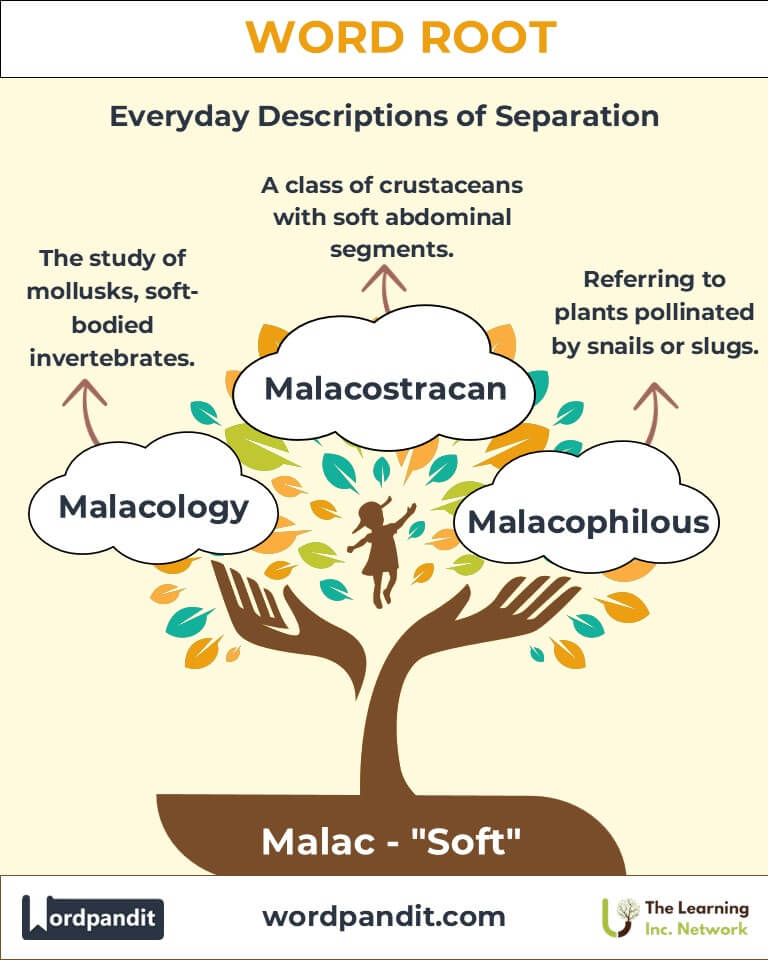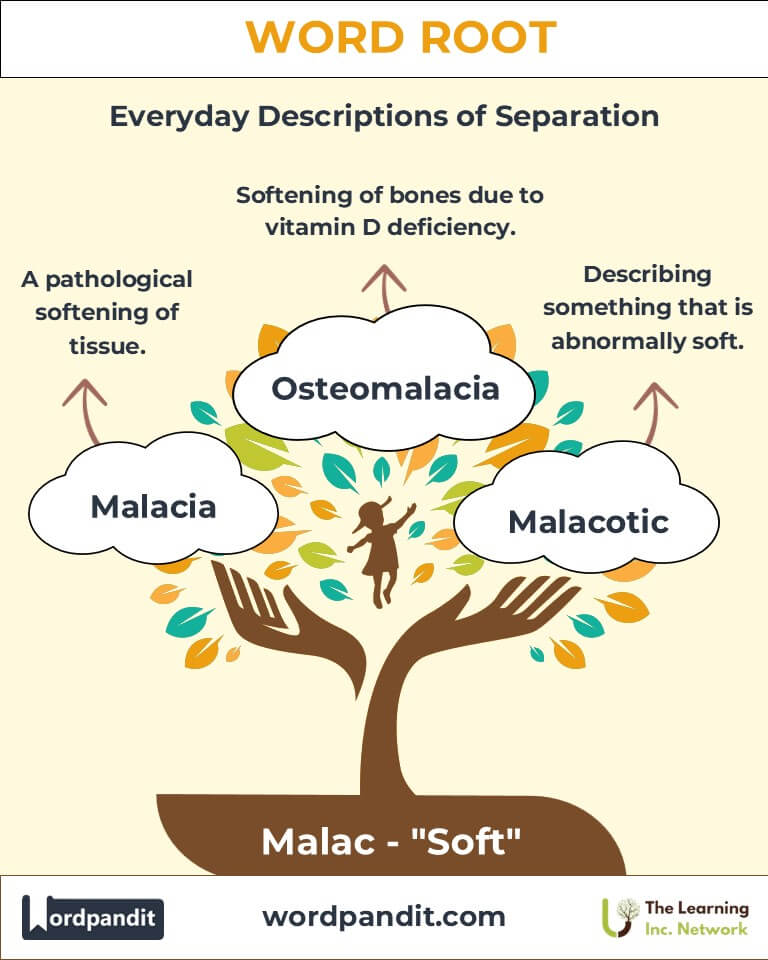Malac: The Root of Softness in Science and Nature
Byline: Discover the fascinating journey of the word root "malac," originating from Greek, meaning "soft." From malacology, the study of soft-bodied mollusks, to malacostracan, a diverse class of crustaceans, this root reveals the world of delicacy and adaptability in nature.

Table of Contents
- Introduction: The Essence of "Malac"
- Etymology and Historical Journey
- Mnemonic: Unlocking the Power of "Malac"
- Common "Malac"-Related Terms
- "Malac" Through Time
- "Malac" in Specialized Fields
- Illustrative Story: "Malac" in Action
- Cultural Significance of the "Malac" Root
- The "Malac" Family Tree
- FAQs About malac the Word Root
- Test Your Knowledge: malac Word Root Quiz
- Conclusion: The Enduring Legacy of Kerat
Introduction: The Essence of "Malac"
The word root "malac," pronounced mah-lak, originates from the Greek malakos, meaning "soft." It forms the foundation of scientific terminology describing organisms and concepts associated with softness or pliability. This root underpins disciplines like biology and zoology, offering insights into the natural world's adaptability and fragility.
Etymology and Historical Journey
The root "malac" traces its origins to ancient Greek, where malakos referred to softness or tenderness. Early naturalists adopted the term in describing organisms with soft bodies, such as mollusks. Over centuries, "malac" became a cornerstone in scientific vocabulary, influencing fields from marine biology to paleontology.
Mnemonic: Unlocking the Power of "Malac"
Picture a soft, delicate mollusk shell resting on your palm, its smooth surface embodying the essence of "malac."
Mnemonic Device: "Malac means soft, like the tender touch of a mollusk shell."
Common "Malac"-Related Terms
- Malacology (mal-uh-KOL-uh-jee):
- Definition: The study of mollusks, which are soft-bodied invertebrates.
- Example: "Her malacology research focused on shell-less slugs and their ecosystems."
- Malacostracan (mal-uh-KOS-truh-kan):
- Definition: A class of crustaceans, including crabs and lobsters, characterized by soft abdominal segments.
- Example: "The malacostracan shrimp is crucial to marine food chains."
- Malacia (mah-LAY-shuh):
- Definition: A pathological softening of tissue in medicine.
- Example: "Osteomalacia, or the softening of bones, often results from vitamin D deficiency."
- Malacophilous (mal-uh-KOF-uh-luhs):
- Definition: Referring to plants pollinated by snails or slugs.
- Example: "Certain tropical plants exhibit malacophilous characteristics."
"Malac" Through Time
- Ancient Roots: The Greek word malakos was initially used in literature to describe tender or pliable objects.
- Scientific Adoption: By the 19th century, biologists began using "malac" to define mollusk-related studies.
- Modern Applications: Today, "malac" extends beyond zoology, influencing medical and ecological terminologies.
"Malac" in Specialized Fields
- Zoology:
Malacology focuses on studying soft-bodied mollusks like octopuses and squids.
- Ecology:
Malacophilous plants exhibit unique adaptations to snail-based pollination.
- Medicine:
Conditions like osteomalacia emphasize the pathological significance of tissue softening.
- Marine Biology:
Malacostracans, such as crabs, play vital roles in aquatic ecosystems.
Illustrative Story: "Malac" in Action
Dr. Elara Bennett, a renowned malacologist, embarked on a mission to document soft-bodied mollusks in endangered coral reefs. Her discoveries, including a rare slug species, underscored the delicate balance of marine ecosystems. Meanwhile, a team of ecologists studying malacophilous plants found that these species thrived in symbiosis with land snails, highlighting nature's intricate web of dependencies.
Cultural Significance of the "Malac" Root
The concept of softness, embodied by "malac," transcends science. In literature and art, "softness" often symbolizes gentleness, fragility, and adaptability. This metaphorical significance finds its roots in natural phenomena, where softness allows survival in harsh environments.
The "Malac" Family Tree
- Mollus (Latin): Soft.
- Example: Mollusk (a soft-bodied invertebrate).
- Malacia (Greek): Softening.
- Example: Osteomalacia (softening of bones).
- Plasto (Greek): Molded, shaped.
- Example: Plasticity (capability of being shaped).

FAQs About the Malac Word Root
Q: What does the root "malac" mean?
A: The root "malac" means "soft," originating from the Greek word malakos. It is often used in scientific terminology to describe softness, flexibility, or pliability in organisms or tissues. This quality is especially significant in biology, where it characterizes the physical nature of mollusks and other soft-bodied creatures.
Q: What is malacology?
A: Malacology is the branch of zoology that focuses on mollusks, soft-bodied invertebrates like snails, slugs, octopuses, and clams. These creatures are often characterized by their soft, unsegmented bodies, sometimes protected by a shell. Malacologists study their behavior, anatomy, and ecological roles.
Q: What is a malacostracan?
A: Malacostracans are members of a class of crustaceans that include crabs, lobsters, shrimp, and krill. While these creatures are not entirely soft-bodied like mollusks, the term "malac" refers to their relatively soft abdominal segments compared to their hardened exoskeletons.
Q: How is "malac" used in medicine?
A: In medicine, the root "malac" appears in terms like malacia, which refers to the softening of tissues or organs. For example, osteomalacia describes the softening of bones due to deficiencies in vitamin D or calcium, leading to skeletal deformities and fractures.
Q: What are malacophilous plants?
A: Malacophilous plants are those that rely on snails or slugs for pollination. This adaptation is typically found in damp or tropical environments where these gastropods are abundant. It highlights the unique ecological interdependence between flora and fauna.
Q: Why is the root "malac" significant in science?
A: The "malac" root signifies the importance of softness in various scientific contexts. In biology, it highlights the adaptability of organisms like mollusks and malacostracans. In medicine, it helps identify pathological conditions. Overall, "malac" captures the essence of softness as both a physical trait and an evolutionary advantage.
Test Your Knowledge: Malac Mastery Quiz
1. What does the root "malac" signify?
2. What does a malacologist study?
3. Which term refers to softening of bones?
4. What is a malacostracan?
5. Which plant type is pollinated by snails?
Conclusion: The Living Legacy of "Malac"
The root "malac" enriches our understanding of softness, both as a physical characteristic and a symbol of adaptability. From mollusks to medical conditions, "malac" reveals the importance of delicacy in natural and scientific contexts. Its enduring legacy reminds us of the value of softness in an often rigid world.











